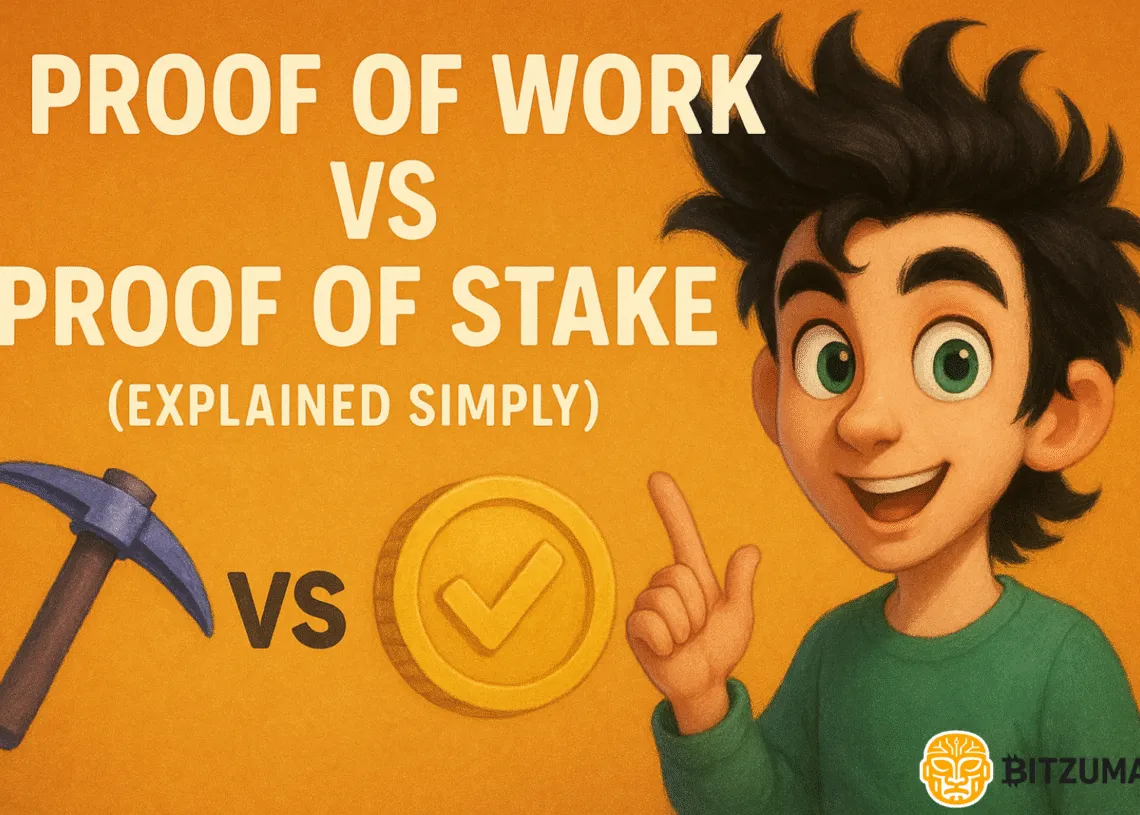-
Blockchain networks don’t run on magic — they run on consensus.
When there’s no central authority, how can thousands of computers agree on what’s true? How do they prevent fraud, validate transactions, and keep the system secure?
That’s where Proof of Work and Proof of Stake come in.
These two systems are the most widely used consensus mechanisms in the crypto world. They’re how blockchains like Bitcoin and Ethereum stay decentralized — without falling apart.
But while both are used to secure networks and add new blocks, they work in very different ways. One requires expensive mining hardware and electricity. The other relies on staking coins and choosing validators.
In this guide, you’ll learn:
- What PoW and PoS actually mean (in plain English)
- How they work behind the scenes
- Why Ethereum made the switch from PoW to PoS
- The main pros and cons of each
Still confused about blockchain basics? Start here → What Is Blockchain Technology? (Simple Explanation)
What Is Consensus in Blockchain?
In the real world, banks and governments act as central authorities — they validate transactions, settle disputes, and keep the system running.
But in a blockchain, there’s no central authority. So how does the network agree on which transactions are real, and which ones are fake?
The answer is consensus.
Consensus is the process that allows thousands of nodes (computers) across the globe to agree on the current state of the blockchain — without needing to trust each other. It ensures that only valid transactions are added, and that everyone has the same version of the truth.
This is what makes blockchain decentralized but synchronized.
To achieve this, blockchains rely on special rules called consensus mechanisms — and the two most popular ones are:
- Proof of Work (PoW)
- Proof of Stake (PoS)
Now let’s break down each one and see how they work.
What Is Proof of Work?
Proof of Work (PoW) is the original consensus mechanism — first introduced with Bitcoin in 2009. And despite newer alternatives, it’s still used by several major cryptocurrencies today.
But how does it actually work?
In a PoW system, network participants called miners compete to solve complex mathematical puzzles. These puzzles aren’t useful in themselves — but solving them proves the miner has spent real computational effort. That’s the “work” in Proof of Work.
The first miner to solve the puzzle gets to add the next block to the blockchain — and receives a reward in the form of newly minted coins, like Bitcoin. This process repeats roughly every 10 minutes in Bitcoin’s case.
Because the puzzles are difficult and random, no one can cheat the system. And since it costs real energy and hardware to participate, it would be extremely expensive for any bad actor to try to rewrite the chain.
Fun Fact: Bitcoin’s mining network consumes more electricity each year than entire countries like Argentina — making it secure, but also controversial in terms of environmental impact.
Despite the criticism, PoW remains one of the most battle-tested and secure systems ever created. It’s been running for over a decade without any successful hacks of the core protocol.
What Is Proof of Stake?
Proof of Stake (PoS) takes a completely different approach — instead of using energy and hardware to secure the network, it uses economic incentives.
In a PoS system, there are no miners. Instead, there are validators — users who “stake” their own crypto (lock it up) to help maintain the network. The more coins you stake, the higher your chances of being randomly chosen to validate the next block.
If you’re selected and do your job correctly, you earn a reward. But if you try to cheat or go offline, you can lose some or all of your staked funds — a process called slashing.
This system removes the need for power-hungry mining and opens up participation to anyone who holds enough tokens. It’s why Ethereum switched from PoW to PoS in 2022, reducing its energy consumption by over 99%.
Pro Tip:
In Proof of Stake, security comes from having “skin in the game” — validators have something to lose, so they’re motivated to play by the rules.PoS is now used by major blockchains like Ethereum, Cardano, Solana, and Avalanche. It’s faster, cheaper, and far more eco-friendly than Proof of Work — but still relatively new compared to Bitcoin’s well-tested model.
Proof of Work vs Proof of Stake: Key Differences
Now that we’ve seen how each system works, let’s break down the key differences between Proof of Work and Proof of Stake — not just technically, but also in terms of user experience, energy use, and security models.
While both aim to secure the blockchain and validate transactions, they go about it in very different ways.
Here’s a side-by-side comparison:
PoW vs PoS at a Glance
Feature Proof of Work (PoW) Proof of Stake (PoS) How It Works Miners solve puzzles with hardware Validators are chosen based on staked coins Energy Use High (electricity + mining rigs) Low (no mining equipment needed) Security Model Based on computational power Based on financial stake Hardware Needed Yes (ASICs or GPUs) No (just a wallet + tokens) Risk of Attack Very low, but costly to operate Slashing penalties discourage bad behavior Used By Bitcoin, Litecoin, Dogecoin Ethereum, Cardano, Solana Eco Impact High carbon footprint Environmentally friendly Fun Fact: After switching to Proof of Stake, Ethereum reduced its energy consumption by more than 99.9% — without sacrificing network security.
Want to know more about Ethereum’s evolution? Read: What Is Ethereum and How Does It Work
PoW vs PoS: Frequently Asked Questions
Is Proof of Stake better than Proof of Work?
It depends on the goal. PoS is faster, more energy-efficient, and accessible. But PoW is more proven over time, especially in terms of security. Each has trade-offs.
Why did Ethereum switch to Proof of Stake?
Ethereum moved to PoS in 2022 to reduce energy use, lower barriers to entry, and improve scalability. The upgrade, known as The Merge, cut its energy consumption by over 99%.
Is Proof of Stake less secure than Proof of Work?
Not necessarily. Both can be highly secure when implemented properly. PoW relies on energy and hardware; PoS relies on financial penalties and incentives. PoS is still newer, but constantly improving.
Can a blockchain use both PoW and PoS?
Some experimental blockchains combine elements of both, but most use one or the other. Hybrid models exist, but are more complex and less common.
Which is better for beginners?
Proof of Stake is generally easier to get involved with — no need to buy mining gear. If you hold tokens, you can stake and earn passive rewards with just a wallet.
Final Thoughts: PoW vs PoS
Proof of Work and Proof of Stake are two very different answers to the same question:
How do we create trust in a trustless system?PoW uses energy, computation, and competition to secure the blockchain. It’s reliable, tested, but power-hungry.
PoS replaces miners with validators — reducing energy use, making participation easier, and opening the door to a more scalable blockchain future.Neither is perfect. Both have strengths.
But understanding how they work — and why they matter — is key to understanding the future of crypto and Web3.
What to Read Next:
- What Is Blockchain Technology?
- What Is Ethereum and How It Works
















